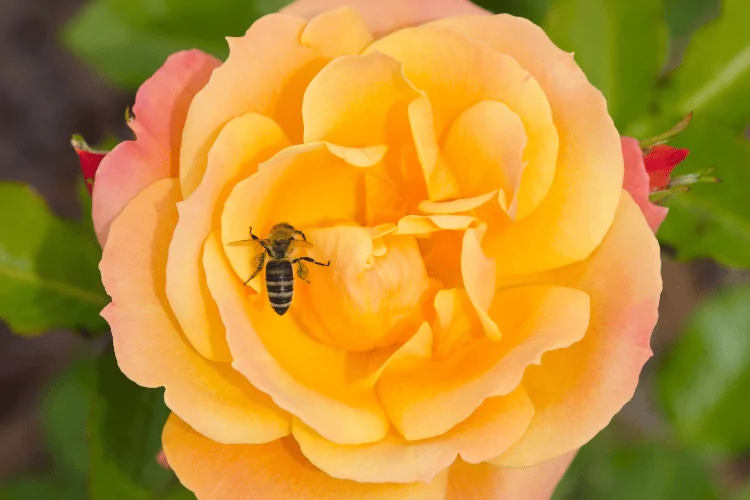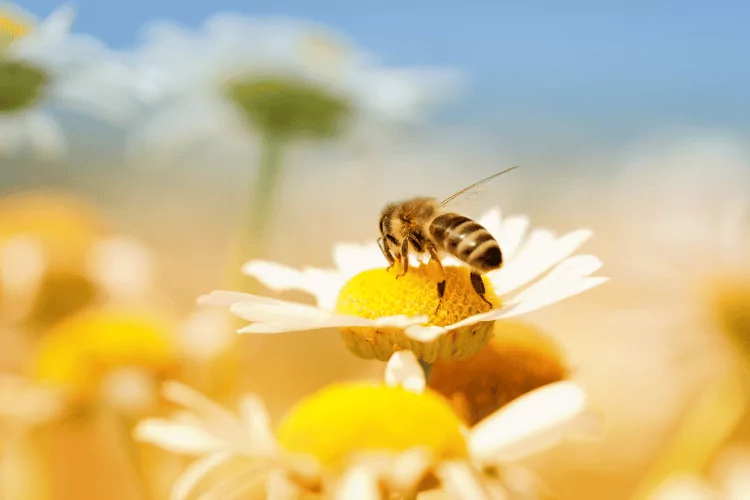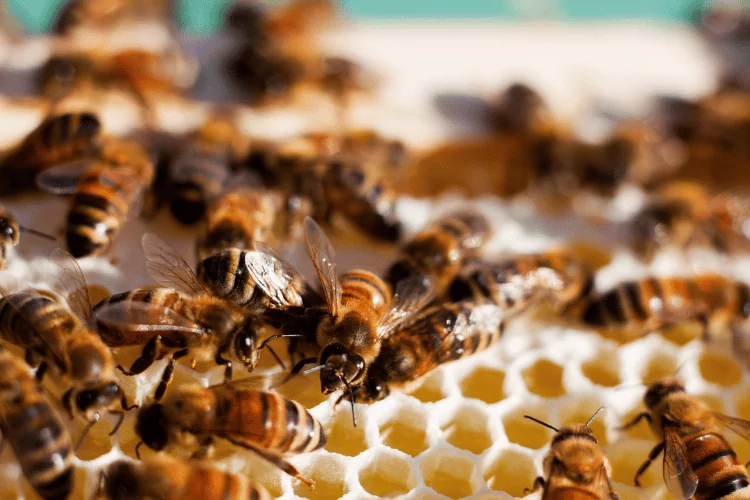Choosing between Italian and Carniolan bees comes down to various characteristics. You might favor the Italian’s calmer disposition or the Carniolan bee’s stronger disease resistance.
Each species has its differences, pros, and cons that can cater to your requirements and beekeeping skill level.
For instance, novice beekeepers will likely prefer working with Italian bees for their gentle temperament.
Meanwhile, you might prefer Carniolan bees if you’re concerned about honey production and hive upkeep. Stick around to learn more about Carniolan vs. Italian bees.
Carniolan vs. Italian Bees: Comparisons
Carniolan and Italian bees are two of the most popular types of bees in professional and beginner beekeeping.
They’re easy to work with and have multiple benefits, such as healthy honey production. Besides that, both breeds hold differences, from their swarming tendency and brood production to their overwintering habits and temperament.
Swarming Tendency
Swarming occurs when honey bees produce new colonies. Their current hive might be overcrowded and too much to handle for the queen bee’s pheromone capacity. Subsequently, they start to reproduce and form new colonies.
That said, Italian bees have an average swarm rate. They tend to reproduce more during spring and summer in their second year.
On the other hand, Carniolan bees are more prone to swarming. They can start reproducing during their first year. The bee’s higher swarm tendency is likely due to a genetic trait. Their queen bee’s brood production can be highly excessive.
Consequently, as she lays the maximum number of eggs, there won’t be enough space for the upcoming bees in 60 days. In this case, beekeepers may add supers to extend the hive structure and allow more room.
Appearance
Appearance-wise, Carniolan and Italian honey bees are similar in size. The prior is usually dark brown with hints of gray and light brown stripes. Their hair is short. The Carniolan bee’s elbow joints are hitched at a relatively high angle.

Italian honey bees also have short hair, but their colors are different. They have yellow and deep brown bands and brown-colored abdomens. They can come in other colors, such as pale yellow and a gold shade.
Italian queens are easy to recognize because they’re noticeably a lighter golden color, making it easier for beekeepers to locate them. In contrast, Carniolan queens are darker than their worker bees.
Honey Production
Carniolan and Italian bees are hard-working honey producers. Nevertheless, one usually outperforms the other, depending on the seasonal changes.
Carniolan bees are more likely to persevere and produce larger quantities on cooler days. Meanwhile, Italian breeds are better performing during warmer temperatures.
Presence
Italian bees have a widespread presence in North America. They’re primarily more popular with beekeepers in the South. The bees are common in professional and hobby settings since they’re relatively easy to manage.
Carniolan bees are slightly less common than Italian bees. They’re still one of the most popular types of bees in the beekeeping market. It’s all thanks to their exceptional honey production and hardiness.
Brood Production
Brood production is when the queen bee lays eggs in every hive cell. The eggs go through three life cycle stages. They start as eggs, become larvae, then pupate. Workers are then responsible for supporting and brood rearing.
The brood cycle usually starts in late winter and continues into spring. Worker bees build chambers or more cells to accommodate the winter cluster. The egg-laying process can extend between two to three weeks.
Spring
As springtime rolls around, Italian queens are usually more proactive in brood production due to the pollen increase. Carniolan queens aren’t as lucky since they need more pollen and nectar supply.
Fall
Since Carniolan bees have delayed brood production in spring, they’re still going strong during fall periods. Italian bees’ nectar supply is now decreasing, reducing brood production.
Wintering
During winter months, bees gather in tight clusters for warmth and survival. They huddle and vibrate, surrounding their queen bee. The worker bees can produce temperatures ranging between 90 to 100 degrees F.
Carniolan bees are more adept at handling harsh winters than their Italian counterparts. They gather in extensive clusters keeping the hive efficiently warm.

The downside is that the bee type can eat more quickly through its honey reserves. Nevertheless, that’s not always the case since some hives can efficiently manage their honey stores and nectar availability and control brood populations.
As a beekeeper, if honey supplies are dwindling, you’ll want to provide the strain of honey bees with sugar water by late winter.
Italian honey bees prefer warmer climates. In turn, winter climates are often challenging for the hive population as they attempt to maintain warmth. They need to utilize all the worker bees in the colony. Otherwise, the Italian hive can experience loss.
The Italian breed can run out of honey as their consumption increases, leading to malnourishment. Another factor worth considering is bee waste. Since the cooler temperatures don’t allow them to fly out, they can defecate in the hive, leaving it unsanitary.
Disposition
Carniolan bees exhibit more aggressive defensive behavior when protecting their hive. In turn, beekeepers often need to spray smoke to calm them. Fortunately, the bee species respond well to the smoke and become manageable.
Meanwhile, you won’t have as much trouble with Italian bees due to their naturally calm temperament. They can become too laid back, leaving round reducer entrances and inviting unwanted guests like hornets and hive beetles.
Disease Resistance
Disease resistance is a crucial aspect worth considering when choosing between Italian or Carniolan honey bee species. In regard to mite resistance, Carniolan bees are better. Italian strains are more vulnerable to illnesses, such as Varroa and Tracheal mites.
In contrast, Carniolan honey bees have a more effective defense system where they bite the Varroa mites’ legs. The action implicates an impressive adaptation to incapacitating new parasite strains.
Drifting Likelihood
Drifting is when bees fly to different hives. It can occur because the hives’ doors are in close proximity, or the hive colors are similar.
That said, moving mistakenly to another colony can reap critical issues like American foulbrood (AFB). It’s a lethal bacterial disease that infects the brood during the pupal stage.
Italian honey bees are more likely to drift than Carniolan species. If you keep their hives in a straight line, it can cause an imbalance in the overall community’s strength. Some colonies will become stronger than others.
Pros and Cons of Carniolan Bees
Carniolan bees are an ideal pick for novice and experienced beekeepers. They offer multiple benefits, but you’ll also want to consider a few setbacks.
Pros
Carniolan bees are excellent honey producers in colder climates. They can also create large quantities of beeswax.
Additionally, the honey bee species are highly organized when delegating tasks to worker populations and modifying their colony population relative to their supply. Subsequently, they’re less likely to stumble upon a shortage of nectar and honey supply.

Carniolan apiaries are more resistant to diseases, incoming pathogens, and parasite infestations.
Cons
Some Carniolan bees may have defensive temperaments, but nothing a few puffs of smoke can’t fix. Aside from that, the bee breed has a high tendency to swarm. Swarming can let you lose almost half of your current colony and reduce honey storage.
It’ll take time for the new colonies to build their resource supply. Swarming tendencies can also pose a risk to biosecurity. If a hive has a parasite infestation or disease, swarming can spread it.
Pros and Cons Italian Bees
There’s a reason why Italian bees are one of the most popular types of bees in the beekeeping industry. They provide several pros that, in most cases, outweigh their cons.
Pros
If you’re new to beekeeping, Italian bees will keep you at ease thanks to their calm temperament. You won’t have to use as much smoke as you would with Carniolan options. Plus, they’re not picky with a new queen, leading to lesser time for brood production.
Italian bees are notable for their large-scale honey production. They also don’t swarm as much as Carniolan bees.
Nonetheless, they still might, especially during spring. During then, you can monitor their nectar availability and provide supers and brood boxes to keep swarming in check.
Cons
Since Italian bees lack an adequate sense of direction, they’re prone to drift, leading to the spread of infections.
Italian honey bees produce broods without accounting for their resources like Carniolan bees. In turn, they go through most of their supplies rapidly, resulting in early shortages and hive collapse.
Carniolan vs. Italian Bees: Which to Choose?
When making your choice, you need to consider your surrounding climate. Carniolan bees are a better fit if you live in a cold area with long-winded winters. Contrastingly, Italian bees thrive better in coastal and warm weather.
Both species are exceptional in terms of honey production. Nevertheless, in terms of disease prevention and defense, Carniolan bees outperform Italian breeds.
Besides that, we suggest contacting your local beekeeper to get advice about which bees can suit your region’s environment and experience level.
- Does Bleach Kill Bees? - April 23, 2024
- How Do I Get Rid of Ants Without Harming Bees? - April 16, 2024
- Do Bug Zappers Kill Bees? Completely Explained - April 9, 2024
